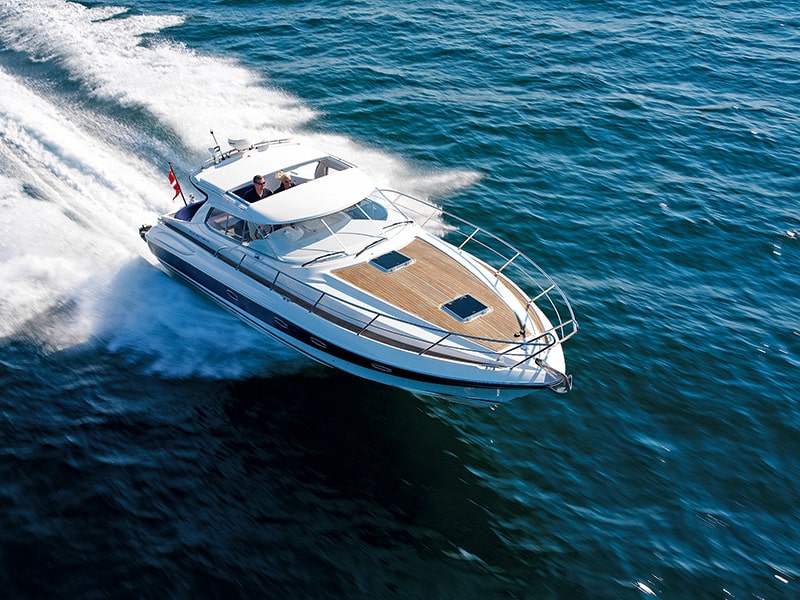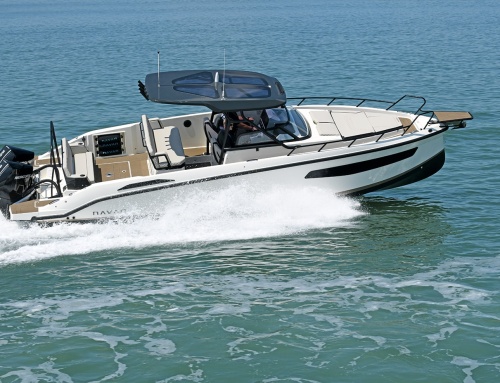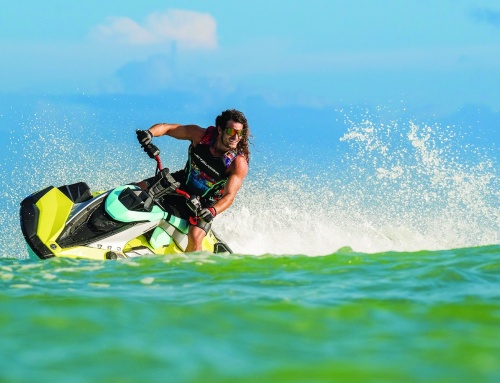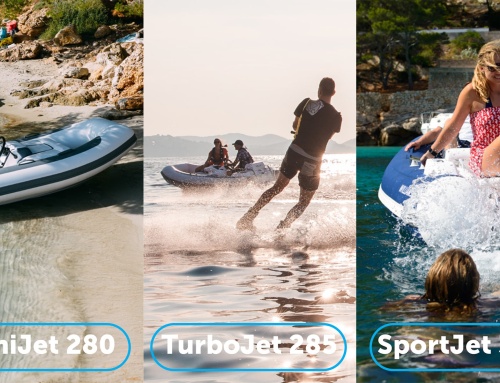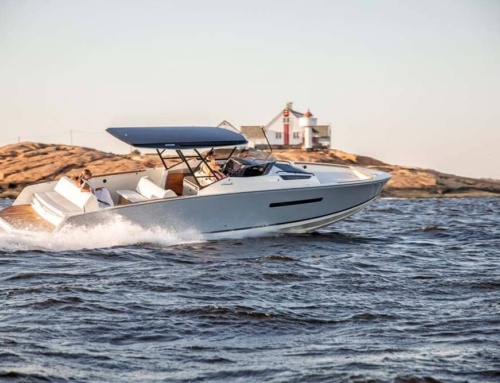- There is one word that describes Windy build and finish and that is ‘superb’.
- The ride is very solid with very little slamming or drumming in the hull.
- Though accommodation is second on the list of design priorities with this boat, it is far from wanting.
Windy Grand Mistral 37
Greg Copp looks back with fond memories as he savours the abundant qualities of a Grand master …
The Grand Mistral 37 was my first Windy experience! It was nearly nine years ago but the memory sits etched in my mind. Sadly it was not mine but Tracy’s boat. Tracy was (and no doubt still is) a dyed-in-the-wool Windy fanatic, keen to spread the gospel by taking me out in a force 6 in the Solent. She had owned her KAD44-powered 2001 boat from new and had even shipped it out to the Far East when work beckoned. Now back in northern waters, her Grand Mistral was doing what it does best – running flat out into a weather nightmare.
I patiently waited my turn and it was not long before Tracy offered me the wheel. I did not want to appear too brutal with somebody else’s boat, Windy or not, so I threw her into some ever increasingly tighter turns for starters. With just over two turns lock to lock, the rakish Grand Mistral can be thrown around like a two-berth sports boat. Even with a strong sea hitting you on the beam at the apex of the turn, the stability of the deep-vee hull is reassuring. We then ran into the eye of the weather, with Tracy encouraging me to nail the throttles for the ultimate upwind Windy experience. I remember thinking, as we cracked on past 30 knots, that most sub-7 tonne sports cruisers would be running at low planing speeds in such conditions.
First introduced in 1998, the Grand Mistral 37 replaced the Grand Mistral 36 by growing 5 inches. Unlike the 36, the Grand Mistral 37 was offered in both open and hardtop versions from the onset, at a time when hardtop sports cruisers were relatively scarce. This Scandinavian aspect of the Grand Mistral would soon prove its worth as the UK summer became increasingly unpredictable. Sleekly styled, the hardtop has a sunroof opening to a third of the roof space. If you succumb to the inevitable craving for some wind in your face, you do not need to be a Scandinavian giant to drive standing with your head out of the top. The helm ergonomics are perfect seated or standing, with a chartplotter under your line of sight.
In the engine department, the twin diesel 230hp Volvo KAD43s of the old 36 were replaced by diesel 260hp Volvo KAD44s on duo-prop sterndrives. There was even the option of diesel 315hp Yanmars with MerCruiser Bravo 3 sterndrives, though these were rare. At only 6.5 tonnes (light), the Grand Mistral 37 was a very fast boat … and still is. From 2002, twin 285hp Volvo KAD300s were available; they were replaced in 2005 with Volvo’s new D4 common-rail injection diesel engines – first in 260hp form and then 300hp. Windy resisted offering the heavier 5.5L D6 engine, which some of her competitors were fitting to similar boats, as they rightly considered the power-to-weight ratio, weight distribution and efficiency spot on with D4s. Performance varied from 38 knots for boats with KAD44s and 260hp D4s to 40 knots or more for boats with KAD300s, 300hp D4s and the big 315hp Yanmars.
As with any pedigree sports cruisers, the secret is in the hull, and every yard has its own spin in this department. Windy combine a particularly narrow waterline beam of 9ft amidships with a distinct flare to the topsides to provide the boat with a topside beam of 11ft 6in. With a bow deadrise angle of 48 degrees, the Grand Mistral is exceedingly rakish where it counts, and the abundance of hull flare helps to keep most of the sea off the foredeck and windscreen. Unusually, the fuel tank on the Grand Mistral is located under the master cabin double berth, instead of the conventional location just forward of the engines. This undoubtedly has a positive effect on the boat’s running trim, efficiency and upwind performance into rough weather.
Though the overall appearance is that of a hull with forward concave sides, it is actually moulded in a series of mildly convex panels to enhance strength. Couple this to well-compacted hand-laid laminates and a closed-cell foam core (enhancing strength while reducing weight) and you have a tough hull, which is held together by some very serious stringers. When you look behind the scenes in the engine room, the standard of build is obvious. The internal laminate quality here is superb; everything is perfectly located, making engine checks a breeze. All ancillaries are mounted where you want them, with plenty of space to get at them, and impressively the fuel filters are located in a separate locker beneath the cockpit. More obviously, the external gelcoat finish is outstanding. Blue-hull boats have always been popular, and looking at About Time, featured in this article, you can see why. Windy gelcoat finish is notoriously good and probably one of the best brands when it comes to resisting sun and salt, which any colour other than white suffers from noticeably over time.
Though accommodation is second on the list of design priorities with this boat, it is far from wanting. The main cabin is comfortably what you expect from a boat built with performance and seakeeping as main priorities. The saloon will sit four snugly, and the galley is a compact affair, which in the case of later boats is very neatly finished in satin oak with a Corian worktop, hob, oven and 65L refrigerator. The heads is also compact and does not boast a separate shower cubicle, which, considering how infrequently people use on-board showers, is not really a major hardship. The forepeak master cabin boasts a good-size double berth and loads of small storage compartments around it as well as two small hanging lockers … It appears not an inch of space has been wasted. When it comes to sleeping accommodation my choice is the mid cabin, which is remarkably spacious, all things considered. There is full standing headroom in the doorway and the wide double berth is bigger than the forecabin.
The cockpit is your typical sports cruiser layout, in this case sporting plenty of helm seating that will take three easily. The horseshoe seating set-up behind will take six around the ultrahigh gloss teak table. The bathing platform boats a fender cage, and in the same practical vein the side decks sport tall guard rails.
A well-known marine surveyor once said to me, ‘If it costs £300,000 to build a boat that is 95% perfect, it will cost twice that to build one that is 100%, therefore few yards cross that 95% barrier.’ It would be fair to say that Windy are one of those few.
Data file
- Build period: 1998 to 2011
- Designer: Hans Jorgen Johnson
- Berths: 4
- Cabins: 2
- Hull type: Deep-vee planing
- Transom deadrise angle: 20 degrees
- RCD category: B for 9
- Current values: From £80,000 to £170,000
- Length overall: 36ft 07in (11.14m)
- Beam: 11ft 6in (3.5m)
- Draught: 2ft 11in (0.9m)
- Displacement: 6.5 tonnes (light)
- Fuel capacity: 178 gal (810 litres)
- Water capacity: 48 gal (220 litres)
- Cruising range: Approx. 300 miles with a 20% reserve at 30 knots
Points to consider
Engines
This boat was originally launched with two engine options of either 260hp Volvo KAD44s on Volvo duo-prop sterndrives or 315hp Yanmar 6LPA-STZPs on twin-prop MerCruiser Bravo 3 sterndrives. The Yanmar-powered boats are rare as the first-generation MerCruiser Bravo 3 drives that they were fitted with could self-destruct if driven hard. The second-generation Bravo 3 X drive that MerCruiser brought out solved this problem. Subsequently the Volvo option proved popular and the KAD44 was replaced by the 285hp KAD300 in 2002. In 2005, the common-rail injected 260hp Volvo D4 replaced the KAD300, with a 300hp D4 offered a few years later. Coupled to Volvo’s DPH duo-prop sterndrives, the D4 engine was a popular and reliable power plant, as were the earlier KAD engines.
Depreciation
The Windy brand is known for holding its value and the Grand Mistral maintains this tradition. The fact that 17-year-old examples are still fetching close to £100,000 shows just how popular these boats are second-hand. If you look at a comparable boat built by a British yard of the same age, you will see how much the Grand Mistral has held its value.
Build quality/fit and finish
There is one word that describes Windy build and finish and that is ‘superb’. This, and exclusivity, is why they hold their value so well.
Buying in Europe
These are Med boats by nature, though they are hugely popular in northern Europe. If you are looking to keep one somewhere warm, buying one out there can make sense as prices tend to be lower. Also, the Grand Mistral’s high-quality gelcoat survives the sun better than most.
Sunroof operation
Some of the pre-2001 hardtop boats had problems with the electrically powered sunroof. It is likely that most will have been rectified as Windy’s warranty care is very good, but it is worth checking if you are looking at a pre-2001 example. Also expect to pay more for a hardtop boat no matter what age.
Running costs
Maintenance
The Volvo D4 will cost around £500 to service, with the KAD44 and KAD300 being slightly cheaper to maintain. The cost of spares has never been a Volvo strong point either in the UK or overseas, however availability and the abundance of service agents are very good in the UK and Europe. If you find a Yanmar-powered boat the cost will be much the same, though some spares are cheaper.
Fuel
Boats with common-rail injected 260hp/300hp D4s will return a healthy 2.5mpg between 25 and 30 knots. The mechanically injected Volvo KAD44s/KAD300s and Yanmar 6LPA-STZPs by their nature will not be so efficient; however, the Grand Mistral’s efficient hull will reap dividends no matter what engines are used.
Choice cut
2009 Price: £185,000
Featured in this article, About Time is located at Lymington and has the popular blue-hull option. Powered by 300hp Volvo D4s, she has logged 280 hours and is fitted with Raymarine electronics. She is one of the last Grand Mistrals to be built in Norway and has been fastidiously maintained. She has the ivory leather interior option and the cabin sole is Old Marsh Oak, which is well complemented by the light satin oak joinery. It’s evident that this boat has been very well cared for above and below decks. All the teak and the covers are in perfect order, with her GRP polished as it was when she was commissioned.
Jim’s words
The Windy Grand Mistral 37 could be considered to be the sports cruiser that sets the standard for all others to follow in this size range. I always look forward to surveying any boat in the Windy range, as the build quality is invariably superb, and as a class they tend to be cherished and well looked after by their owners. In fact, I can remember surveying only one Windy that had suffered from owner-inflicted brutality.
You can get a good idea of the rigid hull design and construction by driving a Grand Mistral 37 at speed in rough waters. The ride is very solid with very little slamming or drumming in the hull.
The older boats may have the Volvo KAD44 or KAD300, both of which are very well-proven workhorses. The subsequent D4 engines had a few issues with their earlier production, which should by now have been rectified under the Volvo ‘Campaign’ after-sales system, but best just to make sure through a Volvo service agent before buying. Beware also of the D4 not initially taking the correct volume of oil when filling, even though the dipstick indicates the correct level, as this has been found to cause damage. Following an engine service, recheck the dipstick after running the engine for about 5 minutes.
Jim Pritchard BSc CEng MRINA MIIMS

